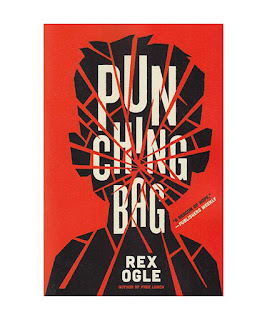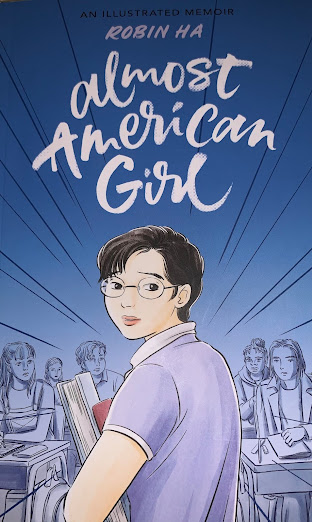Punching Bag by Rex Ogle
Punching Bag by Rex Ogle
Punching Bag’s first lines is a disclaimer, “This is a true story. This is my story. It happened to me. And as painful as it was for me to write, it may be equally or more painful for you to read—especially if you’ve lived through something similar,” which summarizes the experiences of both the narrator and reader (Ogle). However, though this book may be painful to read, it is exactly that reason that makes it such a pivotal novel. This book teaches readers what different types of love looks like through the many bonds Rex, our main character, has throughout the story. And who better to understand these facets of love than young adults who have or will share similar emotional experiences? This book is unapologetically real in its depiction of the toxicity of love and the beauty of mutual passion as told through the author's first-hand account of resilience in the face of emotional and physical adversities proclaimed in the name of love.
The
primary antagonist in Rex’s life is his mother, although, it is this bond
between mother and child that causes the most damage to Rex’s development. This
is made apparent in our introduction to her through Rex’s perception of her, “I
don’t understand why I love my mom so much, and at the same time, why she makes
me so afraid,” essentially highlighting the crux of this stories primary
conflict (Ogle 1). Rex has this utterly devoted unyielding love for his mother
that traps him in his abusive home life. He becomes his mother and brother’s
defender after every fight between Sam, the boyfriend, and his mom. He feels
this sense of obligation because of the familial love he has for these people
in his life, but all it did was constrain him from living a fulfilling life, “I
want a fresh start. I really do. More than anyone. But I don’t know if I can
start again, not until my mom leaves Sam. And she won’t” (Ogle 19). There’s
importance in recognizing that perhaps the relationships that mean the most to
us in actuality hurt the most. Time and time again Ogle recounts his mother’s
physical and emotional abuse which he always justified up until he turned
sixteen. At some point or another, you realize that some forms of love
shouldn’t feel like a burden to bear, they should uplift you.
This positive mutual love comes in the form of Marisa, Rex’s deceased sister, she counteracts the toxic love between Rex and his mother, as she serves as the only support in Rex’s bleak adolescents. Marisa is Rex’s manifestation of the familial love that he wishes he had with his family, but instead, he finds comfort in an illusion, “Then Marisa is there, brushing my hair back from my sweaty brow. She smiles, until I drift off to sleep” (Ogle 60). Though it’s heartbreaking to read about this young boy surviving only because he has his deceased sister's support, it also shows how resilient love makes us. Although Rex’s relationship with his sister is imagined, the love is still there. Out of the entirety of the book they are the only two who show affection and actually listen to each other. This bond serves as an example of what a healthy loving relationship is which is something we all need to see from time to time.
In
summary, Punching Bag is a novel that
focuses on the constraints and freedom love allows shown through the painful
past of Rex Ogle. His parting words in the afterword are ones that oftentimes
need to be heard, “We are all survivors. We all have a past. We all have
tragedy in our lives,” and it’s a realization that many young readers may
experience in their lifetime. The realization that our past doesn’t define us
and we can choose the relationships we keep and continue to nurture in the
future. Overall, Ogle is completely transparent with what he experienced while
growing up and after reading Punching Bag,
it’s a story that should be read to understand the depth of love and recognize
the importance of healthy and mutual relationships.
Biography:
Rex Ogle is an award winning author who moved to New York after college and went on to work an internship with Marvel Comics, then DC Comics, and later at Scholastic and Little Brown Young Readers. He even continued this work as he wrote over a dozen NY Times Bestsellers and worked on (and often wrote) major brands: X-Men, Justice League, Star Wars, LEGO, Power Rangers, Transformers, Minecraft, Assassin’s Creed, Buffy the Vampire Slayer, and Neil Patrick Harris’s Magic Misfits. Much like many other authors Rex Ogle has gone by different pen names; which include: Trey King, Honest Lee, and according to Ogle's website his favorite Rey Terciero which is a nod to his grandmother who used it as a sort of pet name in his youth. He began to write novels and started telling his story through nonfiction works that have gained popularity amongst young adult readers; earning himself several awards and acknowledgements within the author community. Rex Ogle, writer of award winning Free Lunch and 2021 CYBILS Literary Award Winner for Punching Bag; is well known as a middle grade and young adult novelist that expertly creates Nonfiction works. Ogle explains through the use of a trigger warning at the beginning of the Punching Bag novel located within the Author’s Note that the events told in the text are true and difficult to read especially if similar experiences were had. He goes on to declare himself and all those in similar or familiar circumstances survivors of a cruel world that can seem bleak but could turn out amazing.
Instructional Resources:
https://www.purdueglobal.edu/blog/human-services/understanding-domestic-violence/
This website allows students to understand what domestic violence is and how it may affect their peers. By analyzing this website, we ask that students try to reference pieces from this site and apply it to Rex's experiences.
https://www.thehotline.org/identify-abuse/understand-relationship-abuse/
This site is useful for instruction as it gives students resources they might use if they are faced with some form of abuse. This hotline is free of charge and has different features such as: phone calls, texts, and a live agent which allows people different ways to find help if they do not feel safe.
https://www.youtube.com/watch?v=sveQIFwZhR4
Korean film allows students to understand what domestic violence looks like and how to avoid it or get help. In this video we want students to compare and contrast how the video might be applied to Punching Bag.
https://www.youtube.com/watch?v=V1yW5IsnSjo
This TEDTalk explores the story of Leslie Morgan Steiner and her fight to overcome an abusive relationship. This can be used in an in class activity to allow students to comprehend the emotional impact violence has on victims and allows them to discuss the focal points of surviving such an ordeal.
https://www.oed.com/view/Entry/56663?redirectedFrom=Domestic+Violence#eid41827739
This is a link to the Oxford English Dictionary which gives specific definitions of domestic and how the word has morphed through time to create the term domestic violence. Students can use this for a reference to apply to a paper or activity.
https://www.youtube.com/watch?v=7RycBnT2gMQ
This video gives an insight to punching bag through the author's voice and how his memoir might help educate others. Teachers can use this video to allow students to hear about the breakdown of the book and the process that was used to create it.
https://www.safeharborsc.org/blog/safe-harbor-voice/domestic-violence-in-the-hispanic-community
This link allows students to understand how domestic violence is dealt with within the hispanic community. Use this link in an in class activity to apply to Punching Bag.
A website that might be used to teach about awareness day for domestic violence. This link is beneficial as it gives insight to what people might do for their community to rase awareness.
https://www.youtube.com/watch?v=NMDJkWl7E2A
Students can use this video to understand the different red flags that denote to domestic violence. Apply the different red flags to Ogle's experience and find different instances within the text that might show the tell tale signs.
https://www.laurashouse.org/about
Gives students local location of places to go if suffering from domestic violence. Provides counseling, numbers, and shelters.
Instructional Activity:
Preview:
One of the main themes in Punching Bag is anger. Throughout the book, we see Rex deal with the anger in his family and come to terms with the fact that anger does not have to control you and cause you to harm others and that it is possible to control your anger. One of the best methods to help you remain calm when you’re angry is to take a deep breath and visualize things that make you feel happy and calm. In this activity, after students finish reading Punching Bag, they will do a 20-minute free-write activity in which they write about things that make them feel calm and bring them peace/joy. For homework, students will choose images that represent their calm place to print in class the next session. Next class session, students will print, cut out, and arrange these images in a head cutout to emulate the cover of the book.
California Common Core Standards:
CC.SS for ELA Reading Standards for Informational Text 11-12:
Standard 3: Analyze a complex set of ideas or sequence of events and explain how specific individuals, ideas, or events interact and develop over the course of the text.
CC.SS for ELA Writing Standards 11-12:
Standard 3D: Write narratives to develop real or imagined experiences or events using effective technique, well-chosen details, and well-structured event sequences. Use precise words and phrases, telling details, and sensory language to convey a vivid picture of the experiences, events, setting, and/or characters.
Standard 10: Write routinely over extended time frames (time for research, reflection, and revision) and shorter time frames (a single sitting or a day or two) for a range of discipline-specific tasks, purposes, and audiences.Resources and Preparation:
This lesson is meant to take place after the class has finished reading the novel. The instructor can start the lesson by having a class discussion on how anger is used in the novel and how different characters express their anger and how it affects them and those around them.
The discussion can then transition into the introduction of the assignment by talking about ways to reduce and control anger. You can ask the students to imagine that they’re in a position of high stress, frustration, and anger then prompt them to think about the things that help calm them down and make them feel comforted.
In a 20-minute free-write activity, students will write about the things that help them feel calm, comforted, and joyful in a way to combat stress and anger. In this activity, students will practice empathy for the characters in the novel, practice stress management and emotional regulation, as well as practice their creative writing skills.
Students will then go home and find pictures of the things that bring them joy and comfort either from their personal photos or online and compile them into a file so that they can easily print them during the next class session. If the students don’t have access to a printer but the instructor does, they can submit the images for the instructor to print. If there isn’t any access to a printer then students can use crayons or color pencils to draw those images onto the outline. In the next class session, students will arange their images onto the collage to emulate the cover of the book. Not only does this portion of the activity reflect the book’s cover page but it also shows the students that they are made up of the good things that bring them joy and comfort.



